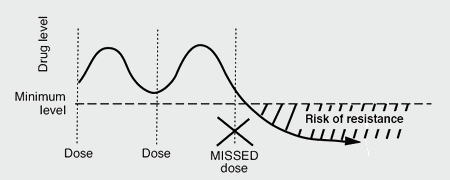3.18 HIV drug resistance
What is drug resistance?
Drug resistance to occurs when HIV makes tiny changes in its structure. These changes are called mutations. This can mean that the drugs no longer work as well or even at all.
You can also be infected with a strain of HIV that is already resistant to some or all HIV drugs.
How does drug resistance occur?
Mutations that lead to drug resistance are usually produced only when you continue taking a treatment with a detectable viral load.
- Resistance can develop even at low viral load levels between 50 and 500 copies/mL.
- If your viral load is still above 50 copies/mL after 3–6 months you may need to change your treatment.
Your doctor should look closely at why the results are not as good as they could be. They will want to discuss how you are managing adherence and side effects. If possible, they should also test for resistance and maybe drug levels.
- Most guidelines recommend you have a viral load test four weeks after starting or changing treatment. This should then be checked regularly when on treatment.
Get the results when they are ready (usually two weeks after your blood was taken). Don’t just wait until your next doctor’s appointment.
What is cross-resistance?
Some drugs are cross-resistant to others.
This means that if you become resistant to one drug you will also be resistant to other similar drugs, even if you have never taken them before. This is particularly true of drugs in the same class.
There are also varying degrees of cross-resistance.
Sometimes you may still get some benefit from the second drug but the response is less likely to be as strong or last as long.
What is a resistance test?
Resistance tests can show if you have mutations that will stop ART from working.
These tests are not available in every country.
If resistance tests are recommended in your country and you are not given one, ask your doctor about this.
In the UK resistance tests are recommended:
- When you are first diagnosed.
- Before starting treatment.
- When your viral load does not get below 50 copies/mL.
- When your viral load rebounds to higher than 200 copies/mL.
- Before changing treatment for drug failure.
What if I can’t get a resistance test?
Some drugs are very vulnerable to resistance.
These include nevirapine, efavirenz, 3TC, FTC, dolutegravir, bictegravir, elvitegravir and raltegravir.
If resistance tests are not available in your country, you can sometimes estimate whether you have resistance depending on your viral load and treatment history.
If you have a detectable viral load especially if your viral load rebounds above 2,000 copies/mL, you have probably developed resistance to at least one drug. If viral load stays this high or keeps increasing, you might have resistance to more than one drug.
How do I avoid resistance?
The best way to avoid resistance is for viral load to become undetectable.
If possible this should be using a test that has a cut-off of 50 copies/mL.
Avoiding resistance is one of the most important conditions for using ART.
You need to use a combination that is potent enough to minimise the risk of getting resistance to any of the drugs you take.
You need to be careful to take your meds and not miss doses.
Missing doses = increased risk of resistance

Further reading
- Section 2 — Viral life cycle, drug resistance and adherence
- i-Base have developed a more detailed online training course of drug resistance. This online course is an learning resource for HIV advocates who want to learn about HIV and resistance. Each module should take 30–60 minutes. It was published in February 2011.
Last updated: 1 January 2023.
